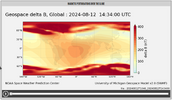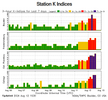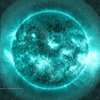mrtn
Dagobah Resident
During the last hour or so, I got neck tension suddenly and a slight headache. So I checked space weather again (did so in the morning already and the Geospace delta B model was strong but I didn't take it to serious yet).
It's KP 8 now and pretty intense, so if you're sensitive to this and feel a little weird, maybe that's why.
I think it's from the triple CME from around the 7th-9th of August. There is also lighting brewing over southern Europe.
It's KP 8 now and pretty intense, so if you're sensitive to this and feel a little weird, maybe that's why.
I think it's from the triple CME from around the 7th-9th of August. There is also lighting brewing over southern Europe.
Attachments
-
 Screenshot_2024-08-12_06-59-42.png291.2 KB · Views: 14
Screenshot_2024-08-12_06-59-42.png291.2 KB · Views: 14 -
 Screenshot_2024-08-12_06-59-59.png294.5 KB · Views: 12
Screenshot_2024-08-12_06-59-59.png294.5 KB · Views: 12 -
 Screenshot_2024-08-12_20-00-57.png133.8 KB · Views: 10
Screenshot_2024-08-12_20-00-57.png133.8 KB · Views: 10 -
 Screenshot_2024-08-12_20-00-06.png112.7 KB · Views: 11
Screenshot_2024-08-12_20-00-06.png112.7 KB · Views: 11 -
 Screenshot_2024-08-12_19-59-24.png118.3 KB · Views: 11
Screenshot_2024-08-12_19-59-24.png118.3 KB · Views: 11 -
 Screenshot_2024-08-12_19-59-06.png116.7 KB · Views: 17
Screenshot_2024-08-12_19-59-06.png116.7 KB · Views: 17 -
 Screenshot_2024-08-12_20-01-18.png157.8 KB · Views: 12
Screenshot_2024-08-12_20-01-18.png157.8 KB · Views: 12 -
 Screenshot_2024-08-12_20-01-46.png319.4 KB · Views: 11
Screenshot_2024-08-12_20-01-46.png319.4 KB · Views: 11 -
 Screenshot_2024-08-12_20-02-40.png95.6 KB · Views: 11
Screenshot_2024-08-12_20-02-40.png95.6 KB · Views: 11 -
 Screenshot_2024-08-12_20-03-11.png232.3 KB · Views: 15
Screenshot_2024-08-12_20-03-11.png232.3 KB · Views: 15 -
 Screenshot_2024-08-12_20-28-55.png212.2 KB · Views: 15
Screenshot_2024-08-12_20-28-55.png212.2 KB · Views: 15



















 ).
).